This page is for the bits of artwork and other cool stuff that don't fit elsewhere.
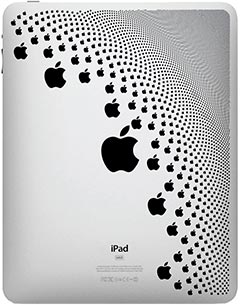
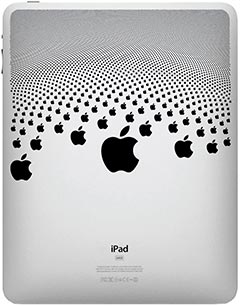
(March 2010) These are two designs I entered into a competition run by Gizmodo to make an image to be etched on the back of an iPad. They were made using Python (with graphics library PyX), Adobe Illustrator, the golden ratio, and a solution to a differential equation to ensure that the density of the apples is constant even as they get smaller.
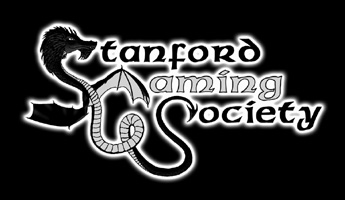
(August 2003) One version of the logo for the Stanford Gaming Society. Getting the wings to be both sufficiently letter-like and sufficiently dragon-like for peoples' tastes was the hardest part.
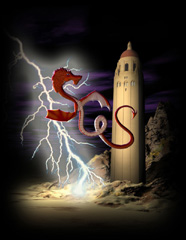
(August 2003) This version is on the back of the T-shirt, the background was created using Bryce by Jeff Rissman. Faintly ridiculous amounts of democracy went into choices of scenery, colours, positioning of the various elements etc.
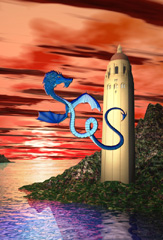
(September 2003) The mellow, serene version, in contrast to the dramatic one above. Background again by Jeff. The tower is an elongated version of Hoover Tower (a landmark on Stanford campus).
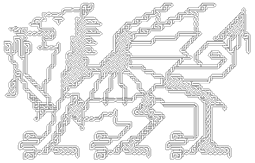
(July 2003) Based on the Welsh flag, I used The Celtic Knot Font to make this. Working with it is similar to doing ASCII art but with even more restrictions.
Spiral Trip
Spiral Trip was a LARP (Live Action RolePlay) I ran with Daniel Ford and Inga Small on Friday 9th Jan 2004. 20 people from SGS participated, Rick Rubenstein, Li Abuabara and my brother Will were wandering monsters (auditors). The LARP had many puzzle-hunt style elements (AKA art projects), these are some of them:
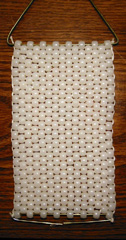
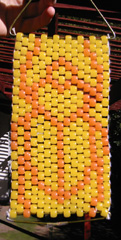
(December 2003) This was a pennant attached to one of two staffs the characters were carrying around. It's made from UV reactive beads, available from teachersource.com (the photo on their website is misleading, the beads go off-white with no sun, but they are not all the same colour. Only the yellow and orange are similar enough for it to work). The left image is what it looks like indoors, or at night, and the right in sunlight (though it was overcast in the morning so this clue didn't work). The scarab beetle is the symbol for Khepri, Egyptian god of the morning sun.
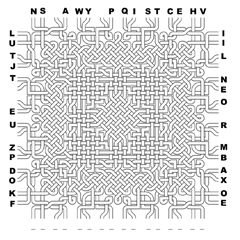
(December 2003) Another use of The Celtic Knot Font. This was printed on a sheet of overhead projector transparency, then cut up into a jigsaw and single pieces of the jigsaw found with other clues and items. When reassembled and solved, it tells the final characters what to do (unfortunately it was 7am by the time people got to this bit, and some pieces had been lost in the chaos...:-)
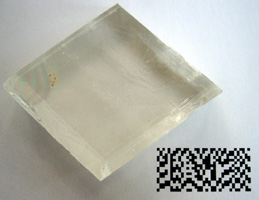
(September 2003) Clicking on the image leads to a page describing the "Crystal of Truth" in detail. Players found the crystal, which allowed them to dechiper the encoded text or pictures. The Crystal of Truth is actually a crystal of "Optical Calcite", also known as "Iceland Spar", which is birefringent. A double image of anything behind the crystal is seen when looking through it. I got my crystal from Ward's Natural Science.
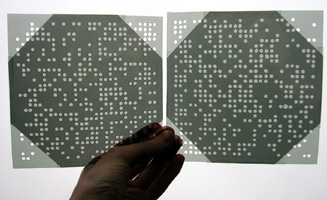
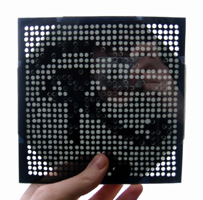
(December 2003) These were two 'amulets' that needed to be found, and only when brought together would they reveal their secret. This is a visual implementation of 'one time pad cryptography'. To encode some message (a block of bits say), produce a random key (another block of bits, of the same length as the message), then the encoded message (ciphertext) is obtained by XORing each bit in the message with the corresponding bit in the key. Then to retreive the message from the ciphertext, simply XOR again with the key. Here one of the amulets is the ciphertext, the other is the key.
The problem is how to visually do the XOR operation. The amulets are each made of two polaroid sheets, one of which has holes drilled in it. Say amulet 1 has sheets named A1 and B1, amulet 2 has sheets A2 and B2, the B's with holes. A1 and B1 have polarising directions at an angle of 45 degrees to each other, likewise A2 and B2. When the two amulets are put together correctly, the order of sheetsgoes (A1, B1, B2, A2). A1 and A2 are arranged with perpendicular polarisations, as are B1 and B2. Then a hole in B1 only gives a sequence of sheets (A1, B2, A2), which is a pair of 45 degree turns in polarisation direction, and by the weirdness of photons and quantum mechanics, some light is let through. Neither the 'black on black' (A1, B1, B2, A2) nor the 'white on white' (A1, A2) let any light through.





















